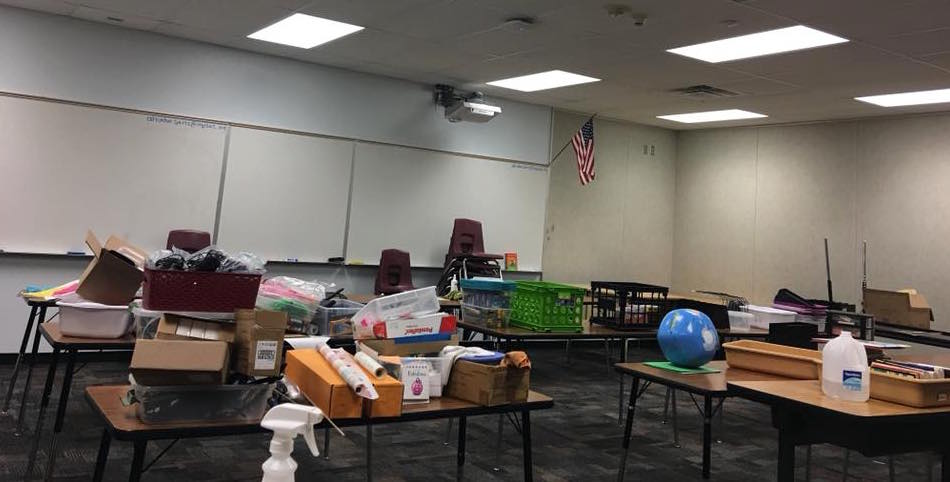“Accomplished English language arts teachers carefully and intentionally design and manage all aspects of the learning environment, from the physical space and the physical resources within it, to the movement of people and objects, the personal relationships within the environment, and the emotional climate created by the interaction of all these elements.” National Board for Professional Teaching Standards, ELA-AYA
I am not going to lie. Seeing the ubiquitous social media posts of teachers’ Pinterest-ready, HGTV-inspired uber-classrooms this August, I felt a mild wave of panic. I had moved classrooms, after inheriting materials from over a half-dozen teachers over the past three years, and having collected what my Mexican-American students and I lovingly refer to as my cochinero at several points around my room. I think cochinero literally means pig-sty?
Anyway, my room was still stacked with boxes I needed to sort through, even after hours and hours of moving, sorting and discarding, and with lots of help from several people. I requested extra storage for our program’s book sets in an office, and, heart-wrenchingly, actually tossed five boxes of torn 1980’s chapter books and science encyclopedias. While I thought they were kind of cool from a retro-kitsch perspective, they were not what my English Learners would pull off the shelves, what with the freckled red-head fourth-graders on the cover or faded black-and-white photos of distant volcanoes and tightly-packed text. Most of them would never have sold at a thrift-shop. They needed to go. I hope someone claimed them from the hallway. But I digress. Suffice it to say that as I saw Facebook swell with photos of enviable classrooms, I felt, to be honest, envious.
I am actually pretty excited about this school year. Our junior high school is implementing a team-based bell-less schedule for students and a host of social-emotional education programs and practices. We have managed to incorporate the required language acquisition courses for our English Learners, and I am learning tons of strategies for building community and supporting students. In the face of these new and exciting challenges, why was I dismayed about my room of all things? Many of the experienced teachers involved with the changes were in the same boat as I was because people were busy for weeks in meetings and trainings making this transition, and almost everyone moved rooms.
I posted a photo of my disassembled room in a Facebook group where teachers were asked to post their room transformations, and of course my teacher friends chimed in to encourage me, commiserate, and let me know everything would be okay. However, seeing all the photos posted of beautiful rooms continued to bother me. I knew I shouldn’t compare, but damn social media, on some level it is really difficult not to.
Then I thought, everything about good teaching is in the National Board standards. Maybe if I went and read the standards, I would feel better! And, bam, the first paragraph of Standard III: Learning Environment (presented at the beginning of this article) put me back into mild panic mode. I am supposed to be carefully designing and managing all aspects of the learning environment, including the emotional impact it may have, and how it lends itself to personal relationships. All of those maddeningly beautiful rooms– I have to admit if I was in 7th grade and walked into a room like that, it would make me feel that the teacher had passion, and had lovingly prepared for me. I would feel special.
But then I continued to read the standard. I found language about relationships with students, mutual respect, safety, and even the variety of groupings an accomplished teacher uses. All of these are part of the learning environment.
I found language regarding purposeful use of space, and even language acknowledging that the virtual environments we create online must be carefully designed. The standards ask us to address student access to digital environments, and also to engage students with the broader community.
The standard honors the importance of classroom routines, concern for others and the design of discussions. In fact, according to the standard, an accomplished teacher, while commanding respect, should “respond comfortably to good-natured irreverence aimed in their direction.” This is one of my favorites. The standard asks us to teach students to accept feedback that challenges their work or ideas. It even mentions the importance of creating a support network with colleagues.
By the time I finished reviewing the standard for the learning environment, I felt a bit better. Nowhere did the highest standards in the land say my posters had to be laminated, or even new. Nobody said I needed different art on the wall than last year. Nowhere could I find where the standard mandated alternative seating. Whew! I did not have to hot-glue felt to jute twine and hand-paint the names of all of my students.
I could breathe a sigh of relief… or at least get to work with what I have. But then I re-read that first sentence again. It did help me reflect on the purpose of a great learning environment: To help students learn and grow. Carefully designing and managing all aspects of the learning environment is still a daunting task, and one with great payoff for our students. The standards, though, helped me broaden my scope and feel that I was not hopelessly behind on everything just because my room was not finished.
I am curious to know how others are dealing with classroom preparation and learning environments in an age of Pinterest, low budgets and digital platforms. What are your thoughts?











Comments 8
You bring this up from a point of frustration, but I miss this time of year as a classroom teacher. I was always stressed by how much work it took to set up a learning space for your news kiddos. But I loved the feeling of planning what my kiddos needed and how I was going to set the room up to meet their needs. How was I going to implement and prepare the new learning I had from the summer? What materials were I going to keep? Do I really need that Lakeshore board game that I have not opened in 3 years? You do bring up a great point. Our classrooms are not just meant to be pretty and comfy. There is an intentionality to how we set it up. It is a purposeful use of space.
Definitely. I have to say it felt really good to unload those science encyclopedias!!!
I love that the standard emphasizes not only the physical environment but also the social/emotional climate of the classroom. I struggle with the physical set up because i teach k-5, and only see my students 35 min per week….the physical environment must accomodate multiple class sizes, development levels, physical needs, and be able to transition immediately (back to back classes: 5th, 2nd, 4th, k….3rd, 1st, k). I’m encouraged to revisit the NBPTS standards for Early childhood Music as pertains to the learning environment!
Wow— that sounds like a set of challenges only an accomplished teacher could master!!!
Great post Amethyst!. I really don’t think you can have one without the other. The physical learning space and the emotional support in the classroom go hand in hand. As you mentioned, ” I found language about relationships with students, mutual respect, safety, and even the variety of groupings an accomplished teacher uses. All of these are part of the learning environment.” I absolutely love transforming my classroom every year into place of wonder for my scholars. My goal and desire, however, is to make sure my little ones know that I genuinely care about their cultural, emotional, and intellectual needs. The physical classroom space is a critical variable in impacting student morale and learning. And of course, the process of creating an engaging learning environment can definitely empower our little ones, help them develop a sense of community and increase their motivation.
I agree. I wish there were more supports in place for this process. Every teacher I know who lovingly prepares that space does it largely at her own expense, on her own time. On the one hand it is a point of personal pride and one way we mentally prepare to meet and teach our students, but the pressure for “picture perfect” is blown so out of proportion from where we were 10-15 years ago, at least in secondary classrooms, and yet no additional resources are given to helping us prepare. How do we decide when we’ve done enough?
I wonder about the emotional impact of my room, too. It’s pretty sterile and I rarely put up any posters, and this year have made a half-way commitment to posting more student work. But at home, I know that I have to set the environment to be able to perform at my best and calmest, so I shouldn’t I also seek the same for my students?
I love this! As a third year teacher in my classroom, there are still things I hope to do (but have not yet had time for!) These things always nag at me. I love that you turned to the NBC standards for guidance and support. Your words are so affirming! There is so much more about a learning environment than what is hanging on the walls. To really see a teacher’s learning environment, you really must see him/her in action with kids in the room. Great post, Amethyst!